September 2024
Aktuelles aus Nordamerika
Kanada hat eine spezifische Mitteilung zu bestimmten Per- und Polyfluoralkylsubstanzen (PFAS) herausgegeben. Gemäß Absatz 71(1)(b) des Canadian Environmental Protection Act von 1999 (das Gesetz) sind, zum Zwecke der Bewertung von Toxizität oder Kontrollmethoden für beschriebene Substanzen, betroffene Personen verpflichtet, bis spätestens 29. Januar 2025 spezifische Informationen bereitzustellen.
Die Hauptinhalte sind:
1. Wer muss reagieren?
Diese Mitteilung gilt für jede Person, die während des Kalenderjahres 2023
herstellte eine Gesamtmenge von mehr als 1000 g einer in Anlage 1 aufgeführten Substanz.
Importiert eine Gesamtmenge von mehr als 10 g einer in Teil 1 von Anhang 1 aufgeführten Substanz ODER eine Gesamtmenge von mehr als 100 kg einer in Teil 2 oder Teil 3 von Anhang 1 aufgeführten Substanz.
Importiert eine Gesamtmenge von mehr als 100 kg einer in Anhang 1 aufgeführten Substanz in einer Konzentration ≥ 1 ppm in einem hergestellten Gegenstand, der NICHT in den Kategorien der hergestellten Gegenstände aufgeführt ist.
verwendete eine Gesamtmenge von mehr als 10 g einer in Anlage 1 aufgeführten Substanz, unabhängig davon, ob die Substanz allein oder in einer Konzentration von ≥ 1 ppm in einem Gemisch oder in einem Produkt vorhanden war, in der Herstellung eines Gemisches, eines Produkts oder eines hergestellten Artikels.
2. Wie man feststellt, ob man die Meldekriterien erfüllt (Mitteilungsabschnitt 2)
Stufenberichterstattung (Mitteilungsabschnitt 3)
Wenn Ihr hergestellter Artikel zu einer der Kategorien gehört und die Schwellenwerte überschritten werden, müssen Sie alle von der Mitteilung angeforderten Informationen bereitstellen.
Wenn Ihr hergestellter Gegenstand nicht in eine der Kategorien fällt und die Schwellenwerte überschritten werden, müssen Sie nur Ihre Unternehmensinformationen gemäß Mitteilungsabschnitt 8 sowie eine kurze Beschreibung und den generischen Namen des hergestellten Gegenstands, der die Substanz enthält, gemäß Mitteilungsabschnitt 9 angeben.
Nachfolger oder Zessionare (Mitteilungsabschnitt 4)
Wird ein Unternehmen während des Kalenderjahres 2023 verkauft, kann eine einzige Antwort, die die Informationen vor und nach der Übertragung zusammenführt, für das gesamte Jahr eingereicht werden.
Ausnahmen (Mitteilungsabschnitte 5 und 6)
Die Mitteilung schließt aus:
Kleinstunternehmen, die weniger als 5 Mitarbeiter haben oder weniger als 30.000 $ Jahresbruttoumsatz erwirtschaften
Die Mitteilung schließt auch Substanzen, Gemische, Produkte und hergestellte Artikel aus, die:
Nur in Durchfuhr durch Kanada oder für den persönlichen Gebrauch
Zur Verwendung in einem Labor zur Analyse oder in der wissenschaftlichen Forschung bestimmt
Als gefährlicher Abfall oder gefährliches recycelbares Material eingestuft sind und der Import / Export in Übereinstimmung mit den Regelungen für den grenzüberschreitenden Transport von gefährlichen Abfällen und gefährlichen recycelbaren Materialien steht.
Registriert unter dem Pest Control Products Act, Fertilizers Act, Feeds Act oder Seeds Act.
3. Welche Informationen werden benötigt (Mitteilungsabschnitte 7 bis 14)
1. Wenn Sie feststellen, dass Sie die Meldekriterien der Mitteilung erfüllen, müssen Sie eine Antwort mit den erforderlichen Informationen geben. Eine Zusammenfassung davon finden Sie unten:
Identifikationsinformationen (Unternehmen / Organisation und meldende Person)
Anlageninformationen
Menge der hergestellten, importierten, verwendeten Substanzen bei der Herstellung eines Produkts und exportierten Substanzen
Informationen zu den Waren
2. Detaillierte Erläuterungen, Beispiele und Tipps zum Ausfüllen Ihrer Antworten zu den Mitteilungsabschnitten 8-14 finden Sie in Anhang A.
3. Es ist wichtig zu beachten, dass, wenn Sie mehr als eine Anlage besitzen, die Berichterstattungskriterien auf Unternehmensbasis berücksichtigt werden müssen. Ihre Antwort auf die Mitteilung muss die Informationen aller im Besitz des Unternehmens befindlichen Anlagen zusammenfassen (Mitteilungsabschnitt 7).
Zusätzliche erforderliche Informationen: Vernünftig zugängliche Informationen; Vertrauliche Geschäftsinformationen.
4.Wie man auf die Mitteilung antwortet
Sobald Sie festgestellt haben, ob Sie die Berichterstattungskriterien erfüllen, gibt es drei Möglichkeiten, auf die Mitteilung zu reagieren:
Antwort auf Abschnitt 71 des CEPA
Wenn Sie die Meldekriterien erfüllen, müssen Sie auf die Mitteilung antworten, indem Sie die erforderlichen Informationen in einer Excel-Berichtsdatei (ERF) an die Regierung von Kanada übermitteln.
Laden Sie das PFAS ERF von der Webseite zur Antwort auf die PFAS-Mitteilung herunter.
Füllen Sie die erforderlichen Informationen aus (Anweisungen sind in Anhang A enthalten)
Reichen Sie das ERF über das Umwelt- und Klimawandel-Kanada Single Window bei der Regierung ein (Anweisungen sind in Anhang B enthalten)
Erklärung des Stakeholder-Interesses (SHI)
Wenn Sie die Meldekriterien nicht erfüllen, aber Interesse an einer meldbaren Substanz haben, können Sie ein SHI einreichen.
Die folgenden sind Teillisten von PFAS, die über die in der Mitteilung aufgeführten PFAS hinausgehen können:
die umfassende globale Datenbank der OECD zu PFAS (Fluorierte Chemikalien (oecd.org)),
das US EPA PFASSTRUCT (Chemicals Dashboard (epa.gov)), und das US EPA PRASDEV (Chemicals Dashboard (epa.gov))(Anweisungen finden Sie in Anhang B).
Erklärung des Nicht-Einsatzes (DNE)
Wenn Sie die Berichterstattungskriterien nicht erfüllen und an keiner der Substanzen interessiert sind, wird empfohlen, eine DNE zu übermitteln, indem Sie eine E-Mail an substances@ec.gc.ca senden. Geben Sie „PFAS DNE“ in der Betreffzeile der E-Mail an und spezifizieren Sie Ihren Firmennamen und Ihre Kontaktinformationen.
Hinweis: Betroffene Personen sind verpflichtet, bis spätestens 29. Januar 2025 spezifische Informationen bereitzustellen. Wie im Leitfaden beschrieben, kann das Versäumnis zu antworten, zu Umweltstrafverfolgungsmaßnahmen und potenziellen Strafen für Einzelpersonen und Unternehmen führen.
In den USA werden bei Identifizierung von Gefahren in Verbraucherprodukten diese zurückgerufen und im Rückrufe der Verbraucherproduktsicherheitskommission (CPSC) Recent Recalls auf der CPSC-Website veröffentlicht, die täglich aktualisiert wird. Die Rückrufe in den USA vom 01. August 2024 bis 31. August 2024 werden nachfolgend zusammengefasst:
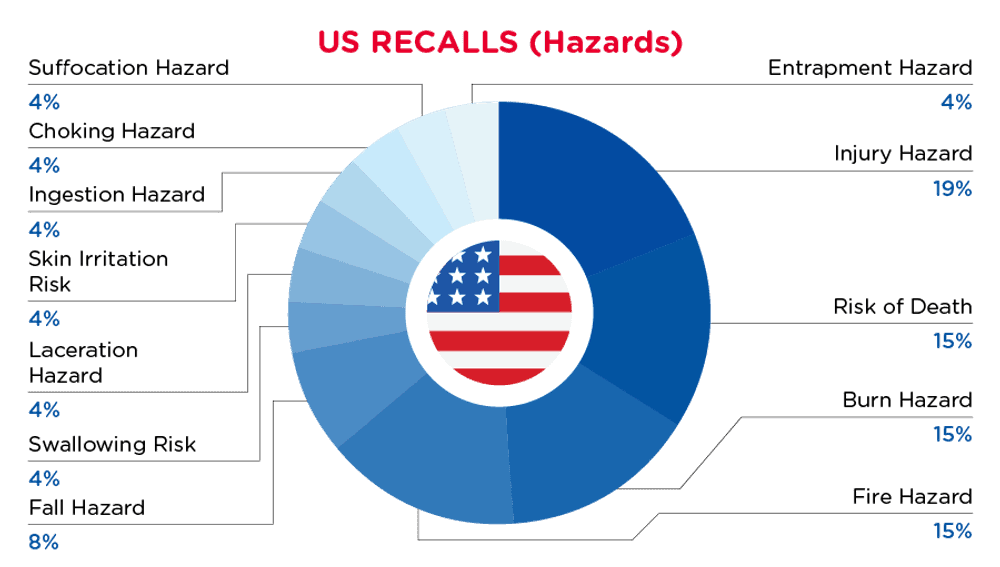
| Gefahren | Frequenz |
| Verletzungsgefahr | 4 |
| Risiko des Todes | 3 |
| Verbrennungsgefahr | 3 |
| Brandgefahr | 3 |
| Sturzgefahr | 2 |
| Risiko des Verschluckens | 1 |
| Gefahr von Schnittverletzungen | 1 |
| Risiko der Hautreizung | 1 |
| Gefahr des Verschluckens | 1 |
| Erstickungsgefahr | 1 |
| Erstickungsgefahr | 1 |
| Gefahr des Einklemmens | 1 |

| Produkt-Kategorien | Frequenz |
| Spielzeug und Kinderpflegeprodukte | 8 |
| Elektrische Geräte | 3 |
| Elektrische Haushaltsgeräte | 3 |
| Haushaltsgegenstände | 2 |
| Sportartikel / Ausrüstung | 2 |
| Chemikalien | 1 |
| Stoff / Textil / Bekleidung / Heimtextilien | 1 |
| Maschinenpark | 1 |
| Outdoor-Wohnartikel | 1 |
Für eine vollständige Liste klicken Sie hier
In Kanada werden bei identifizierten Gefahren in Verbraucherprodukten diese zurückgerufen und im Rückruf- und Sicherheitswarnungsdatenbank auf der Website von Health Canada veröffentlicht, die täglich aktualisiert wird. Die Rückrufe aus Kanada vom 01. August 2024 bis 31. August 2024 werden nachstehend zusammengefasst:
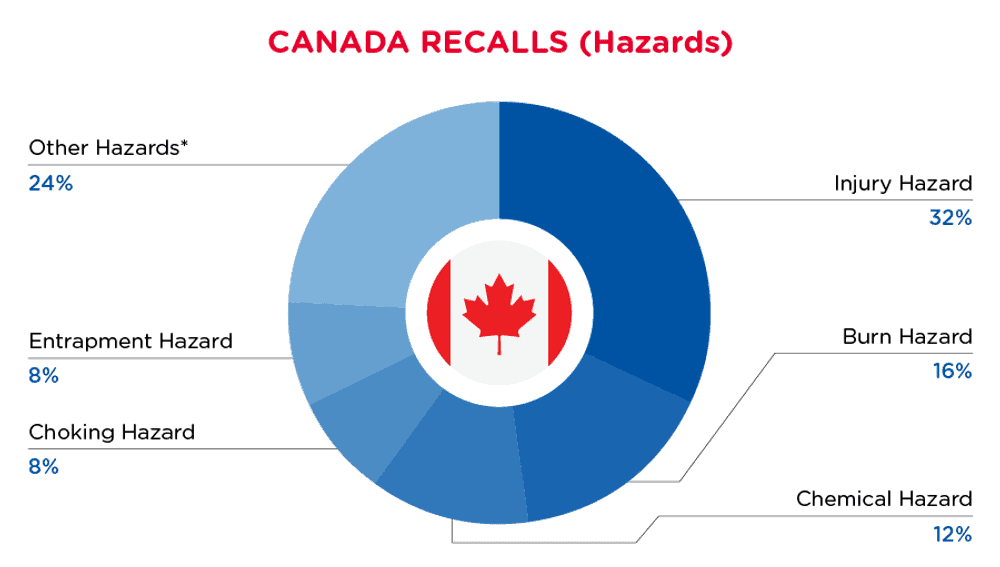
| Gefahren | Frequenz |
| Verletzungsgefahr | 8 |
| Verbrennungsgefahr | 4 |
| Chemische Gefährdung | 3 |
| Erstickungsgefahr | 2 |
| Gefahr des Einklemmens | 2 |
| Andere Gefährdungen* | 6 |
*Andere Gefahren umfassen Schäden am Sehvermögen, Schäden an der Haut, Brandgefahr, Schnittgefahr, Lebensgefahr und Erstickungsgefahr mit einer Häufigkeit von weniger als 2.

| Produkt-Kategorien | Frequenz |
| Spielzeug und Kinderpflegeprodukte | 6 |
| Stoff / Textil / Bekleidung / Heimtextilien | 4 |
| Körperpflege / Kosmetika | 2 |
| Autozubehör | 2 |
| Chemikalien | 2 |
| Elektrische Geräte | 1 |
| Schutzausrüstung | 1 |
| Elektrische Haushaltsgeräte | 1 |
| Maschinenpark | 1 |
Für eine vollständige Liste klicken Sie hier
Neuigkeiten aus Europa
Die Europäische Kommission hat einen neuen Eintrag 79 im Anhang XVII der Verordnung (EG) Nr. 1907/2006 hinzugefügt, der die Verwendung von PFHxA, seinen Salzen und PFHxA-verwandten Stoffen einschränkt. Diese Untergruppen von per- und polyfluorierten Alkylsubstanzen werden in Verbrauchstextilien, Lebensmittelverpackungen, Kosmetika etc. verboten. Hersteller mit verwandten Produkten sollten darauf achten, die Produktkonformität sicherzustellen.
Am 19. September 2024 veröffentlichte die Europäische Kommission die Beschränkung im Zusammenhang mit der Verwendung von Perfluorhexansäure (PFHxA), seinen Salzen und PFHxA-verwandten Stoffen, als einen wichtigen Schritt zur Reduzierung der Emissionen per- und polyfluorierter Alkylsubstanzen (PFAS). PFHxA wird oft als Ersatz für Perfluoroctansäure (PFOA) verwendet, eine weitere bereits verbotene PFAS. Dies wurde als Eintrag 79 im Anhang XVII der Verordnung (EG) Nr. 1907/2006 hinzugefügt, die sich auf den Schutz der menschlichen Gesundheit und der Umwelt konzentriert, indem der verantwortungsvolle Einsatz von Chemikalien gefördert, der Ersatz gefährlicher Stoffe durch sicherere Alternativen angestrebt und die Transparenz über die Eigenschaften und Anwendungen von Chemikalien erhöht wird.
Es wird nach Übergangszeiträumen von 18 Monaten bis 5 Jahren, je nach Verwendung, in Kraft treten, wodurch Zeit für den Ersatz durch sicherere Alternativen bleibt. Hersteller mit verwandten Produkten sollten darauf achten, die Produktkonformität sicherzustellen.
Hat eine lineare oder verzweigte Perfluorpentylgruppe mit der Formel C5F11-, die direkt an ein anderes Kohlenstoffatom gebunden ist, als eines der Strukturelemente; oder
Hat eine lineare oder verzweigte Perfluorhexylgruppe mit der Formel C6F13-.
Die folgenden Substanzen sind von dieser Bezeichnung ausgeschlossen:
C6F14.
C6F13-C(=O)OH, C6F13-C(=O)O-X' oder C6F13-CF2-X' (wobei X' = jede Gruppe, einschließlich Salze)
Jede Substanz, die eine Perfluoralkylgruppe C6F13- direkt an ein Sauerstoffatom an einem der nicht-terminalen Kohlenstoffatome gebunden hat.
1. Referenz für PFHxA-verwandte Stoffe
PFHxA-verwandte Stoffe sind Substanzen, die aufgrund ihrer Molekülstruktur das Potenzial haben, zu PFHxA abgebaut oder umgewandelt zu werden. Eine nicht erschöpfende Liste von Substanzen, die unter den Anwendungsbereich des Beschränkungsvorschlags fallen, ist auf der Website der Europäischen Chemikalienagentur verfügbar.
2. Auslaufzeitplan
| Verordnung | Produkt/Umfang | Anforderung | Datum des Inkrafttretens |
| EU REACH Verordnung (EG) Nr. 1907/2006 Eintrag 79 im Anhang XVII | - Textilien, Leder, Pelze und Häute in Kleidung und verwandten Accessoires für die breite Öffentlichkeit. - Schuhe für die breite Öffentlichkeit. - Papier und Pappe, die als Lebensmittelkontaktmaterialien verwendet werden. - Kosmetika. - Mischungen für die breite Öffentlichkeit. | PFHxA und seine Salze: ≤ 25 ppb PFHxA-verwandte Stoffe ≤ 1000 ppb | 10. Oktober 2026 |
| Textilien, Leder, Pelze und Häute, außer in den unter 1) genannten Kleidungsstücken und verwandten Accessoires, für die breite Öffentlichkeit. | 10. Oktober 2027 | ||
| Löschschäume/ Konzentrate für das Training und für die Tests oder für öffentliche Feuerwehren, außer wenn diese Dienste bei Industriebränden in Betrieben eingreifen, die unter die Richtlinie 2012/18/EU (relativ zu der Kontrolle von Gefahren bei schweren Unfällen mit gefährlichen Stoffen) fallen | 10. April 2026 | ||
| Löschschäume/ Konzentrate für die Zivilluftfahrt (einschließlich auf zivilen Flughäfen) | 10. Oktober 2029 |
Die Beschränkung gilt nicht für Folgendes:
Persönliche Schutzausrüstung im Anwendungsbereich der Verordnung (EU) 2016/425 (legt Anforderungen an Entwurf, Herstellung und Inverkehrbringen persönlicher Schutzausrüstung (PSA) fest).
Medizinprodukte im Anwendungsbereich der Verordnung (EU) 2017/745 (spezifische Verordnung für Medizinprodukte).
In Vitro-Diagnostika im Anwendungsbereich der Verordnung (EU) 2017/746 (setzt Standards für In Vitro-Diagnostika).
Substanzen, die eine Perfluoralkylgruppe C6F13- direkt an ein Schwefelatom gebunden haben, die im Anhang I der Verordnung (EU) 2019/1021 (POP) verboten sind (schützt die menschliche Gesundheit und die Umwelt, indem die Produktion und Verwendung persistenter organischer Schadstoffe (POPs) eingeschränkt oder verboten wird).
Es wird wichtig sein, dass Hersteller sich auf die wirksamen Daten für ihre repräsentativen Produkte konzentrieren, um die Konformität sicherzustellen.
Die Europäische Direktion für die Qualität von Arzneimitteln & Gesundheitswesen hat kürzlich den technischen Leitfaden für Metalle und Legierungen im Lebensmittelkontakt auf die 2. Ausgabe 2024 aktualisiert. Dieser Leitfaden kann sofort angewendet werden.
Am 1. August 2024 hat die Europäische Direktion für die Qualität von Arzneimitteln & Gesundheitswesen (EDQM) den technischen Leitfaden für Metalle und Legierungen im Lebensmittelkontakt aktualisiert. Im Vergleich zur vorherigen 1. Ausgabe stellt die überarbeitete 2. Ausgabe eine bedeutende Aktualisierung dar. Die Hauptänderungen sind wie folgt:
1. Überarbeiteter Anwendungsbereich:
Entfernung der Beschreibung „Metalle und Legierungen, die in Lebensmittelkontaktmaterialien und -gegenständen verwendet werden, die mit einer organischen Oberflächenbeschichtung versehen sind, die nachweislich die Freisetzung von Metallionen auf weniger als die zutreffende spezifische Freisetzungsgrenze begrenzt“ aus dem nicht anwendbaren Anwendungsbereich.
Das bedeutet, dass alle beschichteten Metalle und Legierungen den Anforderungen dieses Leitfadens entsprechen müssen.
Aktualisierte spezifische Freisetzungsgrenze (SRL):
Tabelle 1- SRLs für Metall- und Legierungsbestandteile
| Artikel | Element | SRL in der 2nd Ausgabe (mg/kg Lebensmittel) | SRL in der 1st Ausgabe (mg/kg Lebensmittel) |
| 1 | Aluminium (Al) | 5 | 5 |
| 2 | Antimon (Sb) | 0.04 | 0.04 |
| 3 | Chrom (Cr) | --- | 0.250 |
| 4 | Chrom (Cr) (III) | 1 | --- |
| 5 | Kobalt (Co) | 0.02 | 0.02 |
| 6 | Kupfer (Cu) | 4 | 4 |
| 7 | Eisen (Fe) | 40 | 40 |
| 8 | Magnesium (Mg) | ---b | --- |
| 9 | Mangan (Mn) | 0.55 | 1.8 |
| 10 | Molybdän (Mo) | 0.12 | 0.12 |
| 11 | Nickel (Ni) | 0.14 | 0.14 |
| 12 | Silber (Ag) | 0.08 | 0.08 |
| 13 | Zinn (Sn) | 100a | 100 |
| 14 | Titan (Ti) | ---b | --- |
| 15 | Vanadium (V) | 0.01 | 0.01 |
| 16 | Zink (Zn) | 5 | 5 |
| 17 | Zirkonium (Zr) | 2 | --- |
a Mit Ausnahme des Anwendungsbereichs unter der Verordnung (EU) 2023/915 der Kommission über Höchstgehalte für bestimmte Kontaminanten in Lebensmitteln.
b Der generische SRL von 60 mg/kg Lebensmittel ist nicht anwendbar.
Tabelle 2- SRLs für Metalle als Kontaminanten und Verunreinigungen
| Artikel | Element | SRL in der 2nd Ausgabe (mg/kg Lebensmittel) | SRL in der 1st Ausgabe (mg/kg Lebensmittel) |
| 1 | Arsen (As) | 0.002 | 0.002 |
| 2 | Barium (Ba) | 1.2 | 1.2 |
| 3 | Beryllium (Be) | 0.01 | 0.01 |
| 4 | Cadmium (Cd) | 0.005 | 0.005 |
| 5 | Blei (Pb) | 0.010 | 0.010 |
| 6 | Lithium (Li) | 0.048 | 0.048 |
| 7 | Quecksilber (Hg) | 0.003 | 0.003 |
| 8 | Thallium (Tl) | 0.001 | 0.0001 |
3. Aktualisierte Konformitätserklärung (DoC):
Die 2. Ausgabe 2024 hat das vorherige Kapitel 4 des DoC-Teils entfernt.
Die DoC von in diesem Leitfaden regulierten Produkten sollte den Anforderungen gemäß Abschnitt 8.2 der Resolution CM/Res (2020)9 zur Sicherheit und Qualität von Materialien und Gegenständen für den Kontakt mit Lebensmitteln entsprechen.
4. Optimierte Testbedingungen:
Hinzugefügte Anweisung für Material/Gegenstand im Kontakt mit trockenen Lebensmitteln:
Wenn ein Gegenstand nur für den Kontakt mit einem spezifischen trockenen Lebensmittel vorgesehen ist, sollte er mit diesem Lebensmittel getestet werden.
Aktualisierte Testbedingungen für verschiedene Arten der Migration:
Entfernte spezifische Testbedingungen für befüllbare und nicht-befüllbare Gegenstände; befolgen Sie die tatsächlichen Verwendungsbedingungen oder wenden Sie den Leitfaden des Gemeinsamen Forschungszentrums der Europäischen Kommission (JRC) zu Testbedingungen für Küchenutensilien an.
Geänderte Testmethode für Heißgetränkegeräte:
Ersetzt DIN 10531 durch EN 16889:2016.
Angewandter Reduktionsfaktor von 5 auf den SR von Silber für Silber- oder silberplattierte Besteckteile in den folgenden Produkten:
Typ der Klasse FSI/CAH1* im JRC-Leitfaden, Test mit Zitronensäure als Simulans.
Artikel, die der Norm EN ISO 8442-2 entsprechen, Materialien und Gegenstände im Kontakt mit Lebensmitteln — Besteck und Tafelgeschirr.
Artikel mit Aufschrift nicht für den täglichen Gebrauch oder nicht zum Kochen und Zubereiten von Speisen geeignet.
Dieser überarbeitete technische Leitfaden kann für sofortige Referenz verwendet werden.
Die Europäische Chemikalienagentur hat eine Konsultationsphase für die mögliche Aufnahme von sechs Chemikalien als besonders besorgniserregende Stoffe (SVHC) angekündigt. Sollten diese Auflistungen genehmigt werden, wird die Anzahl der als SVHC anerkannten Stoffe auf der Kandidatenliste auf 247 Einträge aktualisiert.
Am 30. August 2024 hat die Europäische Chemikalienagentur (ECHA) eine 45-tägige öffentliche Konsultation zu sechs neuen potenziellen Stoffen von sehr großer Besorgnis (SVHC) gestartet, wie in der folgenden Tabelle gezeigt.
Sollte dies genehmigt werden, wird die Anzahl der SVHC auf der Kandidatenliste von 241 Einträgen auf 247 Einträge aktualisiert.
Nach Abschluss der 45-tägigen Konsultationsphase wird eine Entscheidung über die Aufnahme der unten aufgeführten Substanzen in die ECHA-Kandidatenliste der SVHC getroffen.
| Name der Substanz(en) | EC-Nummer | CAS-Nummer | Begründung für den Vorschlag |
| 6-[(C10-C13)-alkyl-(verzweigt, ungesättigt)-2,5-dioxopyrrolidin-1-yl]hexansäure | 701-118-1 | 2156592-54-8 | Giftig für die Fortpflanzung (Artikel 57c) |
| O,O,O-Triphenylthiophosphat | 209-909-9 | 597-82-0 | PBT (Artikel 57d) |
| Octamethyltrisiloxan | 203-497-4 | 107-51-7 | vPvB (Artikel 57e) |
| Perfluamin | 206-420-2 | 338-83-0 | vPvB (Artikel 57e) |
| Reaktionsmasse aus: Triphenylthiophosphat und tertiärbutylierten Phenolderivaten | 421-820-9 | 192268-65-8 | PBT (Artikel 57d) |
| Tris(4-nonylphenyl, verzweigt und linear) Phosphit | / | / | Endokrine Disruptionseigenschaften (Artikel 57(f) – Umgebung) |
Das deutsche Bundesinstitut für Risikobewertung (BfR) hat kürzlich Empfehlungen für fünf Arten von Materialien für den Lebensmittelkontakt aktualisiert. Ein Hersteller von silikon-/papier-/temperaturbeständigen Beschichtungen sollte wissen, dass die Prüfmethoden oder Anforderungen überarbeitet wurden. Diese aktualisierten Dokumente können sofort angewendet werden.
Am 1. August 2024 hat das deutsche Bundesinstitut für Risikobewertung (BfR) fünf aktualisierte Empfehlungen zu Materialien für den Lebensmittelkontakt herausgegeben. Nachfolgend sind die aktualisierten Empfehlungen und betroffenen Materialien für den Lebensmittelkontakt aufgeführt:
| Referenznummer | |
| XV | Silikone |
| XXXVI | Papier und Karton für den Lebensmittelkontakt |
| XXXVI/1 | Kochpapiere, heiße Filterpapiere und Filterschichten |
| XXXVI/2 | Papier und Karton für Backzwecke |
| LI | Temperaturbeständige Polymerbeschichtungssysteme für Brat-, Koch- und Backutensilien |
Die Hauptänderungen der Anforderungen und Prüfmethoden sind:
1. Für XV Silikone:
Die Anforderung an extrahierbare Komponenten (Abschnitt III, 5), die 0,5% nicht überschreiten, wurde gestrichen.
Die Prüfmethode für flüchtige organische Stoffe (VOM) wurde aktualisiert:
Tabelle 1
| Artikel | Aktualisierte Version vom 1. August 2024 | Vorherige Version |
| VOM | Nach der Konditionierung wird das Prüfmuster bei 200°C für 4 Stunden getestet. | Nach der Konditionierung wird das Prüfmuster bei 200°C für 4 Stunden getestet. |
| VOM | Artikel, die den oben genannten Prüfbedingungen nicht standhalten können, können alternative Bedingungen in Tabelle 3 von Anhang V der Verordnung (EU) 10/2011 anwenden. | Nach der Konditionierung wird das Prüfmuster bei 200°C für 4 Stunden getestet. |
2. Für XXXVI Papier und Karton für Lebensmittelkontakt:
Die Anforderung für Phthalate bei Recyclingpapier wurde aktualisiert:
Tabelle 2
| Spezifiziertes Phthalat | Aktualisierte Version vom 1. August 2024 | Vorherige Version |
| DEHP | 0,6 mg/kg | 1,5 mg/kg |
| DBP | 0,12 mg/kg | 0,3 mg/kg |
| DIBP | 0,15 mg/kg | 0,3mg/kg |
| Summe (DBPx5 + DIBPx4 + DEHPx1), berichtigt als DEHP | 0,6mg/kg | / |
3. Für XXXVI/1 Kochpapiere, heiße Filterpapiere und Filterschichten und XXXVI/2 Papier und Karton für Backzwecke:
Es gibt keine Aktualisierung der Anforderungen oder Prüfmethode.
Im Vergleich zur vorherigen Version wurden Arten von Zusatzstoffen aufgenommen.
4. Für LI Temperaturbeständige Polymerbeschichtungssysteme für Brat-, Koch- und Backutensilien:
Zusätzliche Anforderung von 10mg/dm2 für die Gesamtmigration des 3rd Migrationstests. Testbedingungen wie folgt:
95% Ethanol, 60°C für 6 Stunden.
Isooctan, 60°C für 4 Stunden.
Aktualisierte Prüfbedingungen für spezifische Migration:
Entfernen Sie die Prüfbedingungen in der vorherigen Version.
Wenden Sie die Prüfbedingungen im Leitfaden des Gemeinsamen Forschungszentrums der Europäischen Kommission (JRC) an für Kochutensilien der Klassen FPU/H2, FPU/H3 und eine geänderte Zeit für FPU/H4 von 4 Stunden.
Verwenden Sie modifiziertes Polyphenylene Oxid (MPPO) als Simulans für den Kontakt von Artikeln mit trockenen Lebensmitteln; die Testbedingung beträgt 175 °C für 2 Stunden (DIN EN 14338).
Wenden Sie die aktuelle Version der Technischen Richtlinie für Metalle und Legierungen der Europäischen Direktion für die Qualität von Arzneimitteln und Gesundheitswesen (EQDM) für Elementmigrationstests an.
Hinweis: Diese aktualisierten Dokumente können sofort angewendet werden.
In Europa, wenn Gefahren in Nicht-Lebensmittel-Verbraucherprodukten festgestellt werden, werden die Produkte zurückgerufen und im Safety Gate System veröffentlicht, das wöchentlich aktualisiert wird. Die Rückrufe in Europa vom 01. August 2024 bis 31. August 2024 sind unten zusammengefasst:
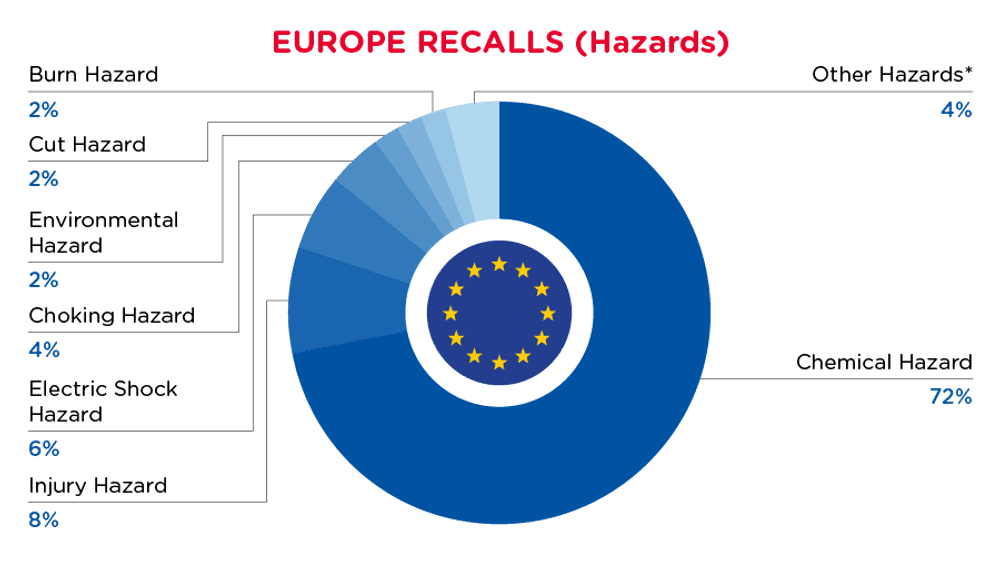
| Gefahren | Frequenz |
| Chemische Gefährdung | 398 |
| Verletzungsgefahr | 42 |
| Gefahr eines elektrischen Schlages | 31 |
| Erstickungsgefahr | 21 |
| Umweltgefährdung | 13 |
| Schnittgefährdung | 12 |
| Verbrennungsgefahr | 12 |
| Andere Gefährdungen* | 24 |
*Weitere Gefahren umfassen Strangulationsgefahr, Sehschaden, Ertrinkungsgefahr, Brandgefahr, Erstickungsgefahr, Hörschaden, mikrobiologische Gefahr und Einklemmen mit einer Häufigkeit von weniger als 7.

| Produkt-Kategorien | Frequenz |
| Körperpflege / Kosmetika | 336 |
| Spielzeug und Kinderpflegeprodukte | 50 |
| Elektrische Geräte | 34 |
| Chemikalien | 33 |
| Maschinenpark | 22 |
| Stoff / Textil / Bekleidung / Heimtextilien | 13 |
| Andere Kategorien* | 35 |
*Weitere Kategorien umfassen Haushaltsgeräte, Outdoor-Lebensmittel, Schutzausrüstung, Sportartikel / Ausrüstung, Schmuck, Computer / Audio / Video / Andere Elektronik & Zubehör, Lebensmittelkontaktmaterialien, Werkzeuge und Hardware, Möbel und Schuhe mit einer Häufigkeit von weniger als 8.

| Notifizierendes Land | Frequenz |
| Italien | 294 |
| Ungarn | 55 |
| Tschechische Republik | 38 |
| Dänemark | 20 |
| Schweden | 15 |
| Frankreich | 14 |
| Finnland | 14 |
| Litauen | 13 |
| Polen | 13 |
| Österreich | 10 |
| Andere Länder* | 37 |
*Andere Länder umfassen Deutschland, Slowakei, Rumänien, Zypern, Norwegen, Irland, die Niederlande, Bulgarien, Belgien und Lettland mit einer Häufigkeit von weniger als 10.
Für eine vollständige Liste klicken Sie hier
Neuigkeiten aus China
In China, wenn Gefahren in Verbraucherprodukten identifiziert werden, werden sie zurückgerufen und im SAMR Defective Product Administrative Centre veröffentlicht, das täglich aktualisiert wird. Die Rückrufe aus China vom 01. August 2024 bis 31. August 2024 werden nachstehend zusammengefasst:
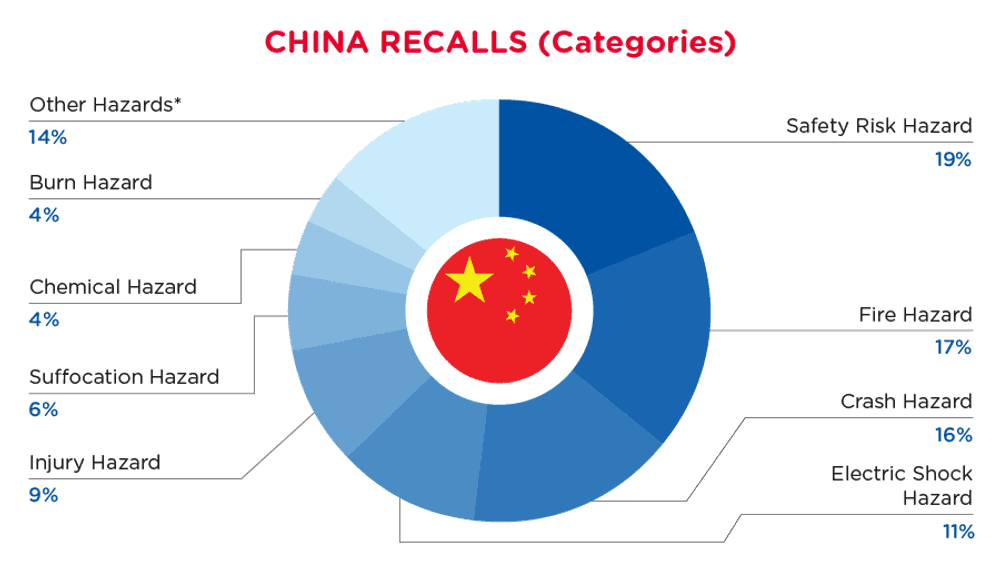
| Gefahren | Frequenz |
| Sicherheitsrisiko Gefährdung | 25 |
| Brandgefahr | 23 |
| Crash-Gefahr | 21 |
| Gefahr eines elektrischen Schlages | 15 |
| Verletzungsgefahr | 12 |
| Erstickungsgefahr | 8 |
| Chemische Gefährdung | 6 |
| Verbrennungsgefahr | 5 |
| Andere Gefährdungen* | 19 |
*Andere Gefahren umfassen Explosionsgefahr, Erstickungsgefahr, Sturzgefahr, Schädigung des Sehvermögens, Schädigung des Gehörs, Durchstichgefahr, Verhedderungsgefahr, Gesundheitsrisiko und Schnittgefahr mit einer Häufigkeit von weniger als 4.

| Produkt-Kategorien | Frequenz |
| Sportartikel / Ausrüstung | 44 |
| Spielzeug und Kinderpflegeprodukte | 21 |
| Elektrische Haushaltsgeräte | 6 |
| Elektrische Geräte | 5 |
| Schreibwaren | 3 |
| Andere Kategorien* | 7 |
*Andere Kategorien umfassen Lebensmittelkontaktmaterial, Computer / Audio / Video / Andere Elektronik & Zubehör, Haushaltsartikel, Stoff / Textil / Bekleidung / Heimtextilien, Schutzausrüstung und Werkzeuge und Hardware mit einer Häufigkeit von weniger als 3.

| Provinzen | Frequenz |
| Guangdong | 28 |
| Zhejiang | 21 |
| Tianjin | 9 |
| Shanghai | 8 |
| Henan | 6 |
| Hunan | 5 |
| Andere Provinzen* | 9 |
*Andere Provinzen umfassen Innere Mongolei, Fujian, Jiangsu, Sichuan, Liaoning und Shanxi mit einer Häufigkeit von weniger als 2.
Für eine vollständige Liste klicken Sie hier
Neuigkeiten aus Australien/Neuseeland
In Australien, wenn Gefahren in Konsumgütern identifiziert werden, werden sie zurückgerufen und in der Datenbank für Rückrufe und Sicherheitswarnungen auf der Website der australischen Wettbewerbs- und Verbraucherkommission veröffentlicht, die täglich aktualisiert wird. Die Rückrufe in Australien vom 01. August 2024 bis 31. August 2024 sind unten zusammengefasst:
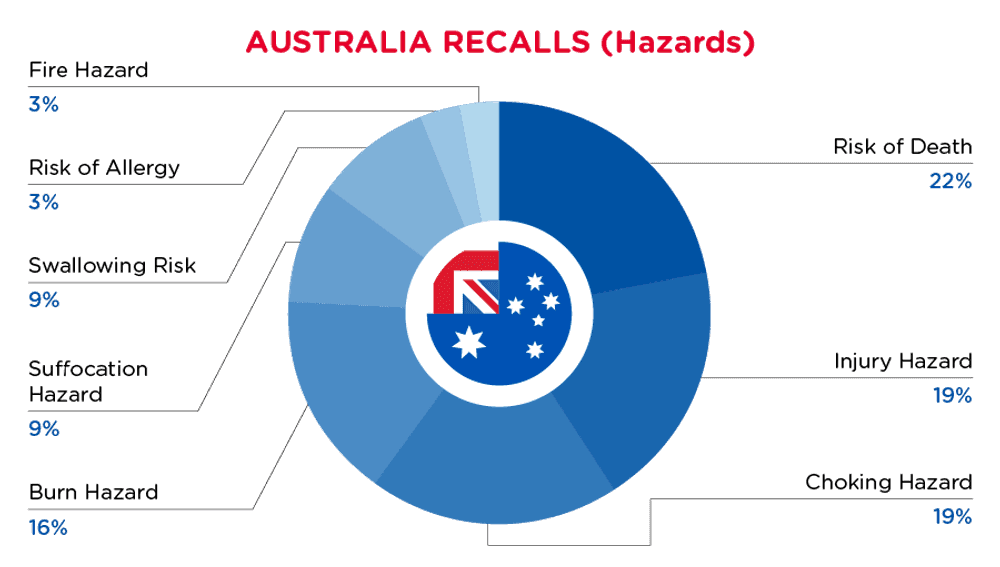
| Gefahren | Frequenz |
| Risiko des Todes | 7 |
| Verletzungsgefahr | 6 |
| Erstickungsgefahr | 6 |
| Verbrennungsgefahr | 5 |
| Erstickungsgefahr | 3 |
| Risiko des Verschluckens | 3 |
| Risiko einer Allergie | 1 |
| Brandgefahr | 1 |

| Produkt-Kategorien | Frequenz |
| Stoff / Textil / Bekleidung / Heimtextilien | 5 |
| Spielzeug und Kinderpflegeprodukte | 2 |
| Elektrische Geräte | 2 |
| Sportartikel / Ausrüstung | 2 |
| Körperpflege / Kosmetika | 1 |
| Haushaltsgegenstände | 1 |
Für eine vollständige Liste klicken Sie hier
Neuigkeiten der US-Bundesbehörden
Am 5. September 2024 hat die Vereinigte Staaten Umweltschutzbehörde (EPA) einen direkten Endgültigbeschluss erlassen, der den Beginn der Einreichungsfrist für PFAS-Daten bis zum 11. Juli 2025 verzögert. Es gibt keine weiteren Änderungen an den Melde- und Aufbewahrungspflichten in der bestehenden Regelung unter TSCA (40 CFR Teil 705).
Die Vereinigte Staaten Umweltschutzbehörde (EPA) hat am 5. September 2024 einen direkten Endgültigbeschluss erlassen, der den Beginn der Dateneinreichungsfrist für die Berichterstattung und Aufbewahrung von per- und polyfluorierten Alkylsubstanzen (PFAS) erforderlichen Daten gemäß dem Gesetz zur Kontrolle von giftigen Substanzen (TSCA) verzögert. Die Verzögerung verschiebt das Startdatum vom 12. November 2024 auf den 11. Juli 2025. Es wurden keine weiteren Änderungen an den Melde- und Aufbewahrungspflichten in der bestehenden Regelung unter TSCA (40 CFR Teil 705) vorgenommen.
Hintergrund zu den Melde- und Aufbewahrungspflichten gemäß TSCA Section 8(a)(7) für PFAS
Wie im Oktober 2023 erlassen, erfordert die Regelung, dass Hersteller (einschließlich Importeure) von PFAS in irgendeinem Jahr zwischen 2011-2022 bestimmte Daten an die EPA melden, die sich auf Expositionen und Umwelt- sowie Gesundheitseffekte beziehen.
Unter Berufung auf allgemeine Haushaltsprobleme und Ressourcenbeschränkungen haben die Auftragnehmer der EPA ihren Aufwand für die TSCA-Informationstechnologie-Software und das zugehörige Portfolio um mehr als 50 Prozent reduziert, was bedeutende und unmittelbare Auswirkungen auf die Fähigkeit der EPA hatte, bei vielen ihrer Informationstechnologie- / Informationsmanagement (IT/IM)-Projekte Fortschritte zu erzielen.
Um funktionierende Berichterstattungsmöglichkeiten sicherzustellen, muss die EPA den Entwicklungsprojektzeitplan verlängern. Daher hat sich der Beginn der Dateneinreichungsfrist vom 12. November 2024 auf den 11. Juli 2025 geändert. Die meisten Datenberichterstatter müssen alle Berichte bis zum 22. Januar 2026 abschließen. Kleine Unternehmen, die Daten ausschließlich zum Import von PFAS in Artikeln melden, haben Zeit bis zum 11. Juli 2026, um Berichte einzureichen.
Auswirkung auf regulierte Einheiten
Strategische Initiativen im Zusammenhang mit PFAS im Rahmen der TSCA-Regulierung haben große Auswirkungen auf Hersteller und Importeure. Regulierte Einheiten müssen nicht nur berücksichtigen, ob ihre eigenen Operationen Produkte enthalten, die PFAS enthalten, sondern auch, ob Produkte in ihrer Lieferkette PFAS enthalten könnten. Der verzögerte Beginn des Berichtszeitraums ermöglicht es den betroffenen Einheiten, sich gut auf diese strenge Berichtspflicht vorzubereiten.
Es sollte beachtet werden, dass trotz der Budget- und Ressourcenprobleme, die zu einer Verzögerung der Datenerfassungsanforderung führten, das Zeitfenster für eine so große Datenerfassung und die Erstellung der obligatorischen Berichte schnell schließt. Dies zeigt das unerschütterliche Engagement der EPA, wie ursprünglich vorgeschlagen, mit dieser Berichterstattung fortzufahren.
Abonnieren Sie unsere regulatorischen Updates
Sie können sich jederzeit abmelden. Lesen Sie unsere Datenschutzrichtlinie.